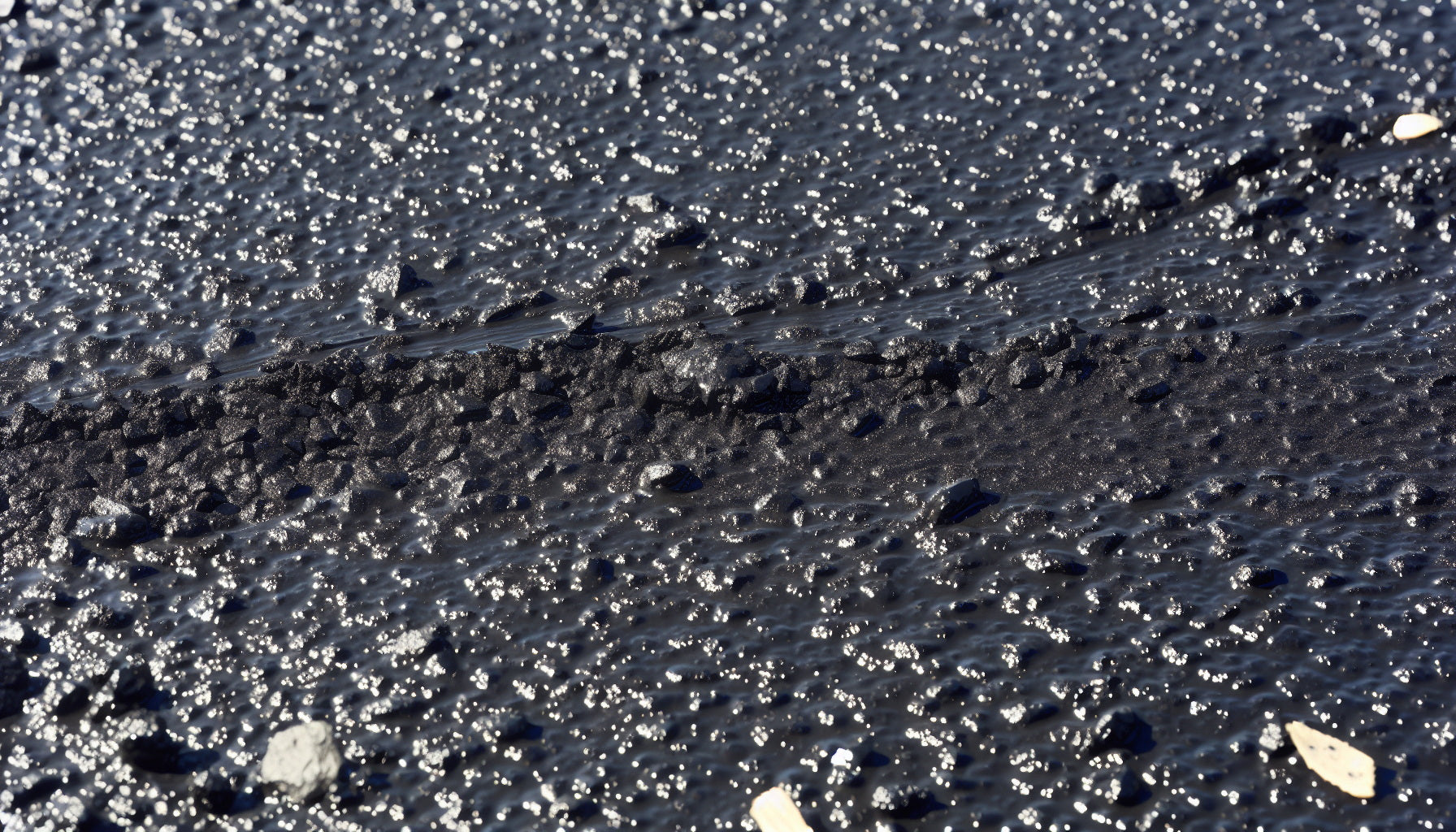Understanding Asphalt Drying Time: How Long Does Asphalt Take to Dry?
Wondering how long does asphalt take to dry? Typically, asphalt dries and is ready for traffic within 48 to 72 hours under ideal conditions, but various factors such as weather and material properties can extend this timeframe. In this comprehensive guide, you’ll discover the key variables that affect asphalt drying time and how to ensure optimal conditions for your new pavement.
TLDR: Key Takeaways
- Normal asphalt drying time ranges from 48 to 72 hours under ideal conditions, but various factors can extend this period to 2 to 7 days.
- The initial 24-hour period following installation is critical for asphalt curing, with several signs indicating vulnerability including a soft surface, strong tar smell, and dark color.
- Asphalt curing is influenced by weather conditions, asphalt mix characteristics, and layer thickness, with full curing requiring up to a year for increased resilience and durability.
Quick Answer: Drying Time for Asphalt Surfaces

For those seeking a concise response, the crux is this: under optimal conditions, new asphalt usually takes between 48 to 72 hours to dry. Nevertheless, various influences can prolong the drying time of asphalt up to a period ranging from 2 days to an entire week.
Patience is key when dealing with a recently laid or rejuvenated asphalt driveway. Allowing adequate time for the curing process ensures that driveways made of asphalt attain increased durability and longevity in their surface quality.
The Initial Curing Phase of New Asphalt

During the first 24 hours following the application of your new asphalt driveway, caution is paramount. This phase is essential as your newly paved surface behaves much like an infant — delicate and requiring tender attention. As the drying process begins, the surface of your new asphalt remains pliable with oils present within the paving material surfacing.
In this initial stage, it’s when wet asphalt embarks on its journey to transform into a robust and durable driveway that you expect.
Signs Your Asphalt is Still Vulnerable
Determining if your new asphalt pavement can withstand traffic might not be as complicated as you think. Be on the lookout for these indicators:
- If the surface is yielding to pressure or adheres to footwear.
- A persistent, intense odor of tar remains present in the atmosphere.
- The deep black shade of the asphalt suggests that oils have not completely evaporated.
Should any of these signs become apparent, it’s an unmistakable signal that your asphalt isn’t yet prepared to handle weight.
Protecting these delicate sections from premature strain is essential in avoiding impressions or harm.
Factors Influencing Asphalt Drying Times

The duration for asphalt to cure is not a fixed period and can be affected by numerous variables. Elements such as weather conditions and the unique composition of the asphalt mix play significant roles in determining the curing time of asphalt, with thicker applications tending towards a slower drying time.
Your asphalt contractor must adeptly manage these factors to guarantee that your new pavement undergoes an ideal process of drying and curing.
How Weather Conditions Affect Drying
The drying process of asphalt is significantly influenced by environmental conditions. The following elements can impact the time it takes for asphalt to dry:
- Ideal weather, characterized by warmth and sunshine, facilitates a swift evaporation of moisture from the asphalt, thereby shortening its cure period.
- Elevated humidity levels serve as an impediment by decelerating this evaporation process, necessitating a lengthier duration for the asphalt to properly set.
- Inclement weather such as rain introduces complications that not only impede quick curing but also risk prolonging the necessary drying time even more.
The Full Asphalt Curing Process Explained

The process of asphalt curing is essential for ensuring the longevity and resilience of your driveway pavement. Here’s a breakdown of what occurs during this period.
-
The oils present in new asphalt begin to undergo oxidation.
-
As a result, the surface starts to harden over time.
-
This newly hardened surface becomes better equipped to handle wear and tear.
-
Gradually, as time progresses, the strength and cure of the asphalt continue improving.
Gaining an understanding of how the asphalt curing process unfolds can enhance your ability to maintain it effectively after you’ve had new asphalt pavement installed.
Even though your initial impulse might be to start utilizing your brand-new asphalt driveway right away because its surface seems dry on touch. Consider that beneath that exterior, there’s still an ongoing full curing process at work within that fresh layering which requires adequate time before normal use should commence.
When Does Asphalt Fully Cure?
The telltale signs that your asphalt surface has completely undergone the curing process are a firm, non-sticky texture and the absence of a strong smell. This stage is also marked by the color transformation from an intense black to a muted gray, indicating that the curing process has concluded.
Allowing anywhere between six months to one year is crucial for new asphalt pavement to transition into fully cured asphalt. During this period, patience is not only commendable, but essential in guaranteeing durability and resilience for your paved surface.
Maintenance Tips During the Curing Period

Navigating through the initial 100 days as asphalt cures can be a challenging task. The intense warmth of summer often leaves oil-based asphalt vulnerable to harm. To preserve your pavement’s structure throughout this period, it is crucial to keep an eye out for heavy vehicles and pointed objects that could permanently scar the surface, which has yet to fully harden.
To protect your parking lot during this critical curing phase, measures such as avoiding hazardous spills and placing plywood under tires where vehicles are parked will help defend against damage from both pedestrian and vehicular traffic.
Why Heavy Traffic Should Wait
It’s essential to reroute heavy vehicle traffic away from your newly installed asphalt driveway. This is because the intense pressure exerted by vehicles, especially when making tight turns, can inflict damage on the surface such as tire marks and excessive wear. By holding off for at least seven days before permitting any vehicle, including personal cars, onto the new pavement, allows the asphalt ample time to harden properly, which greatly diminishes the likelihood of depressions and additional imperfections forming.
Exercising this level of patience will ultimately reward you with a beautifully untouched and evenly smooth surface on your driveway.
Optimal Conditions for Asphalt Installation
The successful installation of a new asphalt surface hinges significantly on the timing. To achieve ideal results, the process should be carried out when temperatures are at or above 70°F—usually in late spring through summer—when dry conditions and elevated nighttime temperatures promote a swift and effective cure process.
On the other hand, winter presents obstacles for laying down fresh asphalt due to its cold climate. Such frigid conditions can lead to premature hardening of the asphalt mix, thus complicating both proper installation and subsequent curing.
Planning Installation Around the Weather
Before initiating the installation of asphalt, it is essential to consider weather conditions meticulously. Ensuring that the ground is dry before starting provides a solid base for the new pavement to properly cure. Contractors who specialize in asphalt pay close attention to weather predictions with an aim to sidestep any potential rainfall which might interfere with the paving process.
Opting for a time when the weather is warm and clear paves the way for an effective and smooth execution of laying down asphalt pavement.
Extending the Life of Your Asphalt Driveway
A well-maintained asphalt driveway not only enhances curb appeal, but also demonstrates attentive and foresighted care. The upkeep routine for your asphalt surface should consist of:
- Frequently cleaning the driveway to eliminate accumulated dirt, debris, and any spills
- Fixing cracks or holes immediately to avoid exacerbating the damage
- Applying a sealant with a sealcoat sprayer periodically—every couple of years—to shield it from elements such as UV rays, automobile fluids, and precipitation.
Adhering to these maintenance steps can dramatically minimize cracking risks and extend the lifespan of your asphalt surface.
Ensuring diligent preservation will allow your asphalt driveway to remain reliable for an estimated two decades while keeping its appearance attractive and holding down repair expenditures.
To Seal or Not to Seal? Timing Your Asphalt Sealer Application
Choosing the appropriate moment to seal an asphalt driveway requires careful consideration of timing and a willingness to wait. If applied at the optimal time, approximately 90 days following installation, sealcoating serves as a safeguard that may prolong your asphalt’s durability. Sealing it prematurely could trap oils and solvents beneath the coating, potentially causing surface problems and hastening its decline.
If you apply the sealcoat after sufficient time has passed, this layer can significantly increase your pavement’s longevity and bolster its ability to withstand environmental conditions.
Asphalt Repairs and When They're Needed
Understanding the optimal timing for asphalt repairs can save both money and time. Indicators such as alligator cracks, pooled water, and distortion in the pavement serve as definite alerts that repair work—or potentially a full replacement—may soon be necessary.
Specifically, cracks in the asphalt that exceed a quarter-inch in width necessitate immediate attention to halt expansion and avoid more significant damage. Rapid response is often key to transforming what could be an extensive reconstruction into a straightforward repair job.
Transitioning From Old to New: Replacing Your Asphalt Pavement
There comes a time when patchwork fixes no longer do the trick, and replacing your entire asphalt pavement is the only option left. This situation arises particularly when extensive areas of the surface need work or if there’s damage to the underlying structure. Embarking on a journey towards fresh asphalt begins with stripping away the old layer and concludes with carefully compacting new material, which restores both strength and visual attractiveness to your driveway.
Opting for repeated minor repairs may appear financially prudent at first glance. Committing to a thorough replacement might actually be more economical over an extended period.
Summary
From understanding the initial 48-72 hour drying time of asphalt to navigating the various phases of its curing process, we’ve covered a vast terrain of knowledge. Maintenance tips, ideal installation conditions, and signs that call for repairs or replacement have all been discussed with the aim of extending the life of your asphalt surfaces. By following these guidelines and recognizing the importance of patience and proper care, you can ensure that your asphalt driveway remains a durable, functional, and attractive part of your property for years to come.
Frequently Asked Questions
How long does it take for street asphalt to dry?
Typically, it takes between 48 and 72 hours for new street asphalt to dry thoroughly. Nevertheless, should the weather present variables such as high humidity or low temperatures, this could extend the curing process to a full week before it is completely cured.
How long after asphalt is poured can you walk on it?
For optimal outcomes, while you can tread on the majority of asphalt surfaces once they’ve dried, it is advisable to wait a minimum of 24 hours following their completion.
Is it OK if it rains after pouring asphalt?
Having rain fall directly after laying down asphalt can harm the newly created surface if it occurs within the first day.
Does asphalt cure faster in cold weather?
Indeed, due to the faster cure of asphalt in cold weather conditions, the duration before it can be used is shortened to potentially just three days, which contrasts with a more extended waiting period experienced in summer.
What time of year is best for installing asphalt?
Installing asphalt is most effectively accomplished in the late spring and summer months, when warm temperatures and dry conditions are prevalent, offering optimal conditions for both installation and subsequent curing.


